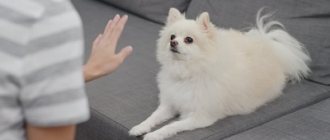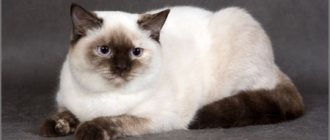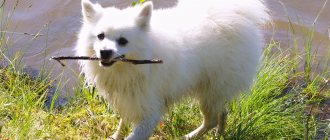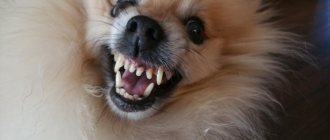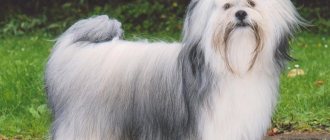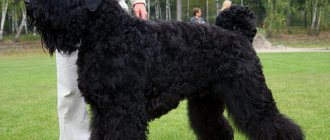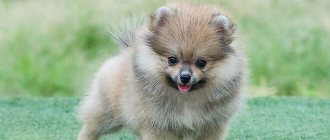History of the origin of the breed
The homeland of the Spitz is Germany. The Pomeranian Spitz breed began to emerge in the 17th century. At this time, there were already two varieties of such dogs - white and black. The dogs were of medium size - their weight reached 14 kilograms. They were popular among the poor population. It was convenient to take such guards into boats on which goods were transported, and they were also used to guard livestock and vineyards. Despite his insignificant physical strength, the sensitive dog, with its ringing voice, barked at the right time, giving a signal that was audible even at a great distance.
Later, dogs began to attract attention because of their attractive appearance. In the mid-18th century, the German princess Charlotte of Mecklenburg-Strelitz, who became the wife of the British King George 3, took a small Spitz with her to England. In the country, the small variety was quickly appreciated and registered as an independent breed. Breeders began to strive to breed a similar miniature-sized dog, and soon individuals appeared whose weight was no less than 9 kg. Their coat color was the same as those brought from Pomerania - white or beige.
Further rapid development of the breed was observed during the reign of Queen Victoria. From Florence, the queen brought a Spitz, miniature for that time, which weighed 5 kg. And then Spitz dogs with a rating came into fashion - the less, the better.
The first breed standards were approved in 1871. They were still different from those that are used today when evaluating dogs, but already provided for the weight of the animal from 2.5 to 3.5 kg, and also increased the number of possible colors - cream and red, black, peach and spotted were added.
Today, the Fédération Cynologique Internationale classifies Pomeranians as part of the German group, classifying them as miniatures as a separate subgroup. The American Canine Association considers these Spitz a separate breed. The last amendments to the dog standard in the International Canine Federation were made in 1998. They are still in effect today.
Spitz: breed features
The breed has other characteristics that have nothing to do with its character and behavior. These include the following:
- Good endurance and adaptation. Despite the fact that the dogs are quite small, they have good endurance. They also quickly adapt to different weather conditions and tolerate frost and summer heat without problems.
- Cleanliness. Many dog breeders compare representatives of this breed with cats. They also like to devote a lot of time to licking their fur, so they are considered very clean.
- Absence of breed diseases. These dogs have strong immunity and therefore do not have specific diseases.
Note! If dogs are fed mostly fatty foods, they will begin to gain weight quickly. Therefore, you need to properly think through your diet.
Interesting Facts
There are many interesting facts associated with the Pomeranian Spitz breed that the owners of these decorative dogs will be curious to know.
- The name of the breed in German translates as “sharp.”
- The first guard Spitz dogs were poor people's dogs. Only 100 years after the breed was officially recognized, it began to be of interest to breeders and nobility and gradually turned into toy companions.
- The Pomeranian was Isaac Newton's favorite.
- Today, movie, pop and sports stars choose the Pomeranian Spitz as their four-legged friend.
- The dog has a decisive character, which is why it is sometimes called “little Napoleon.”
- Spitz is mentioned in the story "The Lady with the Dog".
- Despite their toy appearance, dogs are smart and can not only be trained according to basic commands, but also perform complex tasks.
- The Spitz puppy closely resembles a bear cub and is darker in color than adult dogs.
There is a lot of interesting information about any dog breed, and each breed has its fans.
Breed standards
The description of the breed used today has been established since 1998. It includes the following characteristics:
- size – different for a male (from 18 to 22 cm at the withers) and for a female (from 16 to 20 cm at the withers);
- weight – different for males (from 1800 g to 2300 g) and females (from 1400 g to 3000 g);
- paws – medium length;
- head - the skull resembles a fox, the dome-shaped shape is a defect;
- body – round, stocky, with moderately voluminous breasts;
- trimming – allowed around the paws, on the hips;
- wool – with a thick undercoat, long guard hair;
- movements are smooth, free and easy;
- temperament – lively, but with caution;
- color - divided into three groups: black, orange and others acceptable by the standard.
Minor deviations of the dog from the standards cause a decrease in its show ratings. Severe defects cause rejection.
Varieties
The Pomeranian is a type of German Spitz. Due to the fact that the breed was bred not only in different countries, but also on different continents, 3 forms of Spitz were adopted in the standard. They differ in the shape of their muzzle.
- Bear type. Such a dog has a round, tending to rectangular, muzzle. Its flatness is allowed.
- Fox type. The muzzle is similar to a fox, somewhat elongated, has a narrow chin and a button nose.
- Toy type or toy. Similar to the bear variety, but has a more flattened and shorter muzzle. The eyes are set wider apart and slightly higher.
Experienced breeders claim that during shows, judges often give preference to the classic bear-type dwarf Pomeranian. The fox type of muzzle is more valued in small Spitz dogs.
Also among the dwarf varieties, there are two more that are not included in the category of classic German Spitz. This is a Japanese and American Eskimo Spitz.
The first appeared in the 20-30s of the 20th century. It has an absolutely snow-white color. Height at the withers is up to 40 cm. A distinctive feature is that the dog practically does not bark.
The second is also white, inherited from its northern dog ancestor. The American variety is divided into two groups: toy – the dog’s height at the withers is up to 30 cm, and miniature – the dog’s height is up to 38 cm.
The standard American Spitz stands out separately. The height of dogs of this variety at the withers is up to 50 cm.
Other Features
One of the striking character traits of this breed is courage and fearlessness.
The small size of dogs does not at all prevent them from defending the house from uninvited guests.
At any time of the year, dogs are ready to spend the whole day outdoors playing and having fun.
In winter they enjoy playing in the snow; in summer they like to swim or lie on the ground. Playfulness and curiosity are wonderful qualities of any Spitz.
They are ready to discover the world around them every day. Balls and sticks are the best toys for small dogs. Pomeranians can tinker with them around the clock.
Due to this character trait, dogs lend themselves well to training using play methods . Under these conditions, the dog will learn much faster. By about five months, the puppy masters all the basic commands. During such training, the owner and the puppy will become closer emotionally; both will find this activity interesting and comfortable.
Pomeranians love to travel with their owners.
They can easily be carried in a carrier or simply carried.
Natural curiosity does not let them get bored. Playing with children also brings moments of joy to dogs.
Over time, pets learn the intonations in their owner’s voice, then adapt to his mood. Any category of the population, be it an elderly couple or a young family burdened with children, can afford a dog of this breed.
For medicinal purposes (animal-assisted therapy), Pomeranians are recommended for communication with children. All this thanks to quick wit, intelligence and special contact responsiveness. Pomeranians help sick people, help them find not only health, but also a true friend.
Character and temperament of the Pomeranian Spitz
The dog has a friendly character and a high degree of curiosity and pertness. She will constantly explore everything around her, even while in an apartment where she knows everything. If you want to have a pet that will keep you company while watching movies in the evening, lying next to you on the couch, choosing a Spitz will not be a suitable option. The Pomeranian requires constant movement, he loves to walk in the fresh air, and if there is the possibility of free walking in the garden, this causes special delight and a surge of energy in the Spitz.
The dog loves active games outside, willingly carries a ball and overcomes small barriers. When walking in an unfenced area, it is not recommended to let the Spitz off the leash, as it can easily get carried away by chasing a bird, insect or rodent and get lost.
Dogs of this breed are characterized by active manifestation of protective qualities, so they fearlessly try to protect their owner from everything that seems to them a threat. This behavior looks very funny and gives the Pomeranian even more charm.
Important! The desire to dominate can push a Spitz into conflict with a large dog, which poses a danger for him. You should keep your pet on a leash during walks.
The Pomeranian very easily finds a common language with the owner, all family members, as well as with pets. He quickly adapts to the rhythm of home life and will not require early walks if the owner gets up late. To make your pet comfortable, it is advisable to teach him to use a litter box from childhood, which is quite easy given the high intelligence of a Spitz.
The Pomeranian is distinguished by its devotion and constantly follows its owner at home and on the street, but only until the moment when something particularly captivates him. The dog tends to show its love very violently, especially rejoicing when meeting, which is why it is sometimes intrusive.
The pet does not tolerate prolonged loneliness well: it negatively affects its mental health. When it is not possible for any of the family members to be with him all the time, the Pomeranian needs to provide other company. It can be composed by a dog or a cat, ideally so that the puppy grows up with them. It is especially good if you purchase 2 puppies from the same litter. This allows you to reduce the stress of moving to a new place, and also makes the dog’s physical development more harmonious, since it will be able to constantly play, training its muscles.
The temperament of the Orange Spitz is quite violent: it begins to bark due to any noise and may not shut up for a long time. Proper education will significantly reduce this phenomenon. The Spitz shows all emotions very brightly and strongly, a little over the edge.
Character and behavior
The character of Pomeranian dogs is strikingly different from other small breeds. Despite external appearance, the pet is endowed with courage and intelligence . Behavioral features include:
- Leadership. Spitz easily get along with new people, and in the family circle they try to take center stage.
- Love for training. Breeding and raising Pomeranian puppies is not complete without training teams. For kids, this is tantamount to an interesting game, so they are happy to make contact.
- Attachment. Pomeranians are afraid of loneliness, so they constantly jump after their owner in any direction.
- Loud barking. With his barking, the dog not only accompanies danger, but also expresses joy.
- Ability to manipulate. An animal's intelligence can turn against its owner. Attentive dogs, noticing human reactions to their antics, use bipeds to their advantage.
- Activity. The restless pet is happy to take any walk and loves outdoor games.
Physical data
The dog is mobile, active, and needs long walks. The small size makes the Spitz quite fragile, so it is necessary to prevent the animal from jumping from great heights and children from playing with it excessively. In winter, the dog does not need clothing, as its coat is dense and protects well from the cold. In autumn, in damp weather, it is better to dress your pet in order to protect its fur from contamination, which will be quite difficult to tidy.
Appearance of a Pomeranian Spitz
The Spitz dog breed, especially the orange one, is distinguished by its attractiveness. They simultaneously resemble a fluffy toy and northern dogs (especially the eyes and ears, as well as the tail thrown over the back). The main characteristics of the Pomeranian's exterior, as defined by the breed standard, are given below.
- Head. Has a medium size. The forehead is wide and round. The transition from forehead to nose is clearly defined. The nose is much shorter than the frontal part, not pointed.
- Mouth. The lips are dry, closed, painted black. The teeth are small. Their set is complete. Scissor bite.
- Ears. Standing. They have a triangular shape. Landing is close.
- Eyes. Medium in size, slightly slanted, giving the dog a slightly cunning appearance. The look is always lively and interested. The color of the iris is brown - from dark to amber.
- Body. Compact, proportionally folded. The back is straight, turning into a short croup. The chest is deep and wide. The neck is of medium length, appearing quite short due to the abundance of fluff and fur.
- Paws. Straight, parallel, with a fairly wide arrangement. Provides the dog with good stability. The hock joints of the hind legs are strongly developed, giving a springy gait. The foot is rounded. Fingers fit tightly together
- Tail. Middle length. Set high and, like northern dogs, lies on the back.
Regardless of the color of the orange and the type to which it belongs, the main characteristics of its appearance will be the same.
Significant deviations from them are grounds for lowering show scores or even preventing the dog from participating in shows. If there are serious defects in the exterior, it is highly recommended not to let the animal go into breeding.
Attitude towards the owner and family members
The love of representatives of this breed for their owner has absolutely no boundaries. Small dogs protect him from any, even the slightest, danger. A stormy meeting of the owner from work, accompanying him everywhere around the house - this is only a small part of the dog’s care.
Dogs are keenly aware of their owner's mood and therefore worry if they have problems. When the owner is depressed, the dog will not bother him, will occupy an observation post nearby, and will wait. As soon as the pet feels that the friend is ready to communicate, joy will know no bounds.
The character of Pomeranians is interesting for another feature - they easily adapt to the owner’s biorhythms.
If the owner likes early walks, the dog will happily run with him in any weather.
If the owner is inclined to soak up under a warm blanket until late in the morning, the dog will not miss the opportunity to stay with him longer.
Both the owner’s habits and lifestyle in general will suit the furry creature quite well. The owner and the dog are like a single whole, their relationship is built on complete trust in each other.
In a family with small children (up to four years old), there may be some difficulties in communicating with a Spitz puppy . Dogs of this breed have fragile, thin bones, and children, unwittingly, can injure the puppy in play.
Dogs are tolerant of children. But if a child unknowingly accidentally offends a Spitz, the memory of this will remain in the dog’s mind for a long time. In the future, during games and simple communication, the Spitz will be restless and irritable.
To strangers
Distrust of strangers is characteristic of representatives of this breed.
Therefore, puppies should be accustomed to strangers as early as possible. Otherwise, the dogs will disturb others with their loud barking.
After all, any person who approaches a dog, even with good intentions, will cause an attack of loud barking.
In addition, the pet gives a voice when it tries to get a response from its owner to its actions. A dog also barks if something bothers it. Despite its small size, the Spitz can get into a fight with a larger opponent. He will not think about the outcome of the battle.
Therefore, during walks, especially on dog parks and in busy places, it is necessary to keep your pet under constant supervision. A small dog can be aggressive towards other animals.
Breeders, when describing the breed, note that Pomeranians are fearless and brave dogs.
They always bravely defend their owner and home from the attacks of strangers. And this is always accompanied by a loud barking.
Other animals
In the owner's house, the Pomeranian Spitz gets along quite calmly with other animals. Much depends on the timing of the appearance of other pets.
If the puppy appears when there are already other dogs and cats in the house, then friendly relations between them will quickly develop.
An adult Spitz may react with dissatisfaction to the arrival of a new family member. From time to time, grumbling will be a sign of dissatisfaction in the relationship with the owner. Especially when you spend more time with other animals. To maintain peace in the house, the owner of the Pomeranian must evenly distribute his attention to all pets.
Content Features
Proper maintenance of a dog ensures the preservation of its health and maximum extension of its life. Proper care of your pet is required from the first day of its arrival in the house.
Feeding puppies and adult dogs
The Spitz is an omnivorous dog species that can easily digest ready-made dry or wet food, as well as natural food. If your pet does not have allergic reactions, it is advisable to give preference to a natural diet, when food is prepared at home from fresh ingredients.
A dog should not be considered a eater who will consume all the leftovers from the master’s table. Improper feeding will cause health problems, and in some cases can even cause death. When creating a menu for your Spitz, you should use the following products:
- lean meat in its raw form - if the dog refuses to eat it, then give it scalded with boiling water (boiled meat is not required);
- offal - boiled;
- hard-boiled egg yolk – no more than 2 times a week. If chicken yolk is used, then it is given in the amount of 1 piece, if from quail eggs - then 2 pieces;
- lean sea fish, boiled and completely cleared of bones and scales;
- fermented milk products - mainly cottage cheese and kefir;
- porridge – preference should be given to buckwheat, rice, rolled oats. You can cook them separately or mix them together;
- vegetables - various, with the exception of legumes;
- fruits are necessary, but you should not give your dog very sweet ones, such as grapes;
- greenery.
Important! It is useful to season your pet's porridge with vegetable oil. You need to choose sunflower or olive oil of the highest grade. This addition to the diet significantly improves the quality of wool.
The vast majority of Spitz dogs cannot tolerate fresh milk. It causes them diarrhea and abdominal pain. If the dog is an exception and does not react negatively to the product, then it is allowed to give it sometimes, but not more than once a week.
The drinking bowl must always contain clean water, which is changed twice a day. It is better to use unboiled, settled tap water or spring water.
The number of feedings per day is the same as for all dogs. Puppies are fed 6 times and adult pets - 2 times a day. Pomeranians are prone to overeating and their portions should be regulated.
Walks
Strictly required at least 2 times a day and lasting from 1 to 2 hours. Letting your pet off the leash in an unfenced area is highly discouraged. It’s good if the dog has the opportunity to play actively outdoors.
Hygiene
Does not differ from that recommended for other breeds. The eyes and ears are wiped once a week with a cotton swab, which for the eyes is moistened in a calendula solution, and for the ears - in an antiseptic. Nails are trimmed as needed.
Grooming
The dog needs to be brushed daily. Washing is carried out no more than once every 45 days or as needed. In this case, you need to use a special shampoo for dogs. If the dog does not participate in exhibitions, it can be cut, which will be more convenient for itself and the owner.
Care and health
A pet’s luxurious, soft fur coat is the main indicator of health and care. The Spitz sheds in the spring, decorating the territory with its fur and terrifying its owners.
For excellent health and appearance of the animal, adhere to the following recommendations:
- Brush the coat about 2-3 times a week. When shedding, brushing is done every day.
- Take your pet for haircuts. Long fur interferes with movements, sheds heavily and takes over the house.
- Swim twice a month. Dirt ingrained into a fur coat will give it an untidy appearance, so only hygiene procedures can save it. It is also necessary to periodically clean your ears. A clean animal is not able to do this on its own.
- Walk your Pomeranian regularly. Active pets need exercise. At the same time, climatic conditions are not a hindrance for these dogs.
- Attend preventive examinations. Early diagnosis simplifies the treatment of any disease.
- Maintain good oral hygiene. Pomeranians' weak point is their teeth, so careful care will protect them from dangerous diseases. It is better to visit the dentist once a year by appointment, so as not to miss the next appointment.
- Keep your daily diet balanced. Spitz dogs tend to be overweight, so overfeeding is prohibited.
- Train your pet from an early age. From 5 months, the puppy begins to remember basic commands. Timely education of Pomeranian Spitz puppies is the key to the adequacy of an adult animal.
Compared to the Kleinspitz, that is, the small German Spitz, which has an impressive list of breed diseases, the Pomeranian is a real treasure. It is also attractive that with proper care, the maximum age reaches 16 years.
Education and training
The dog is distinguished by its rapid assimilation of commands and good adaptation to specific conditions. It is necessary to raise a puppy from an early age, which will greatly simplify its maintenance. Training is carried out in a playful way, without the use of corporal punishment or rudeness. Representatives of the Pomeranian Spitz dog breed are distinguished by a vulnerable psyche and can become seriously ill from this.
Health, diseases and breed defects
Unlike most dwarf dogs, Spitz dogs are in good health. This is primarily due to the fact that they have the blood of northern dogs, which are particularly resilient. Even old dogs remain active, lively and feel good. At the same time, due to their very thick coat, they are prone to tangles if they are not brushed daily or if their coat is washed too often.
Alopecia can also sometimes occur, in which certain areas of the dog's body become bald. Some animals that belong to the show class may develop black skin disease, in which the fur is completely lost and the skin becomes pigmented and dark. This condition does not pose a danger to the life or health of the pet, but completely spoils its appearance.
Merle-colored dogs are considered to be quite weak. They are often born with deafness, high intraocular pressure and a defect in the structure of the eye membrane. Also quite often there are problems in the functioning of the heart, blood vessels, nervous system and musculoskeletal system. Because of this, when choosing such a pet, you should pay special attention to its parents. If they have pathologies, you should refuse to buy a puppy.
The main reasons for culling a dog are discrepancy between weight and height, as well as incorrect build or pubescence. If the dog is not acquired for breeding and exhibitions, then these defects will not matter to the owner, since they do not affect the health of the Spitz and its attractiveness. The character will remain unchanged.
Lifespan
Pomeranians are long-lived. Usually the pet lives up to 15 years . However, there are not isolated cases when a dog lives for 18-19 years. In particularly elite individuals, who are often not in very good health, the lifespan may be slightly reduced - up to 12-14 years.
Brief history of appearance
The Spitz is a miniature dog breed with a calm character.
The Spitz is a German breed. They first appeared in the northern province of Germany - Pomerania. It is because of this that the dog got its name - Pomeranian Spitz. It is worth noting that his ancestors were not always very small. Only in the second half of the 19th century did English dog breeders begin to reduce the size of Spitz dogs. They managed to create a unique breed that has survived to this day.
Looking at the success of the British, breeders from other European countries also began to modify dogs. By the beginning of the 20th century, this breed began to be found everywhere not only in European countries, but also in America.
Additional Information! It was after their appearance in America that the popularity of dogs began to increase significantly.
How to choose a puppy
You should purchase a puppy only from a reliable nursery, which will provide all documents not only for the offspring, but also for the parents. The puppy should be active, with no discharge from the nose or eyes, or signs of diarrhea. The presence of fleas or worms is unacceptable. An excessively bloated abdomen indicates problems with the intestines. It is not advisable to choose the smallest puppy from the litter, as it will be weaker than the rest.
Diseases
Diseases in dogs of this breed can occur due to:
- Small size.
- Hereditary pathologies.
- Anatomical properties.
- Improper care.
Anatomical properties
Quite often, problems with teeth appear and they begin during the period of changing teeth. The fact is that they have long tooth roots, which prevents the natural loss of teeth. As a result, problems arise with bite and development of molars.
To prevent this, periodic examination of the dog's teeth is necessary. If problems are detected, namely inhibition of the development of molars by baby teeth, you need to consult a doctor who will help get rid of the problem by removing baby teeth.
Another problem can be tartar . If you notice an unpleasant odor from your dog's mouth, this is the first sign of advanced tartar. Reasons: heredity, improper care, malfunction of the gastrointestinal tract or liver.
Tartar appears due to dental plaque, which must be removed periodically.
To prevent its occurrence, you need to brush your dog’s teeth with a brush and a special dog paste.
If this is not done, gum inflammation may develop or lead to tooth loss.
The next anatomical disease is sudden cough. Spitz dogs have an unusual structure of cartilage in the larynx. When these cartilages spasm, a cough appears. The spasm occurs after physical exertion, for it to go away it is necessary for the dog to calm down.
The next possible problem is the eyes. Due to the structure of the skull, the eyes are often affected by strong winds, dust, or suffer in hot weather. Then tears begin to fall from the eyes. To solve the problem, you need to use special eye drops. Tears may also leak due to inflammation, eye damage, or abnormal tear flow. To treat such diseases, you must consult a veterinarian.
Hereditary diseases
- Hypothyroidism is a disorder of the gastrointestinal tract due to pathology of the endocrine system. Symptoms: lethargy, rapid weight gain, dermatitis, hair loss.
- Epilepsy is a malfunction of the brain. The disease cannot be treated and may not appear immediately. During an attack, convulsions and loss of consciousness are possible. At this point, an anticonvulsant should be administered.
- Dwarfism is congenital dwarfism due to the fact that growth hormone is not produced. Complications in the functioning of the nervous system, baldness, and protruding eyes are possible.
- Unfused fontanel – non-fused skull bones.
- Congenital problems with the spine and umbilical hernia are also possible.
- Small size. Because of it, diseases of bones and joints most often occur. Weak ligaments in a dog can lead to dislocated knees. This happens when there is a lot of stress on the joints during games. Manifested by lameness and fatigue. Bone displacements and fractures are very common. Don't let your pet jump from high places.
Improper care
It is necessary to treat the animal for fleas and ticks. This needs to be done once every three months . Otherwise, the following diseases may occur: dermatitis, encephalitis, allergies and others.
An unbalanced diet will lead to diseases of the liver and kidneys, joints, malfunction of the gastrointestinal tract, allergies, etc. Do not overfeed the dog.
Lack of fresh air and physical activity will lead to weakening muscles and a decrease in the animal’s immunity. Carry out hygiene procedures. This will help avoid diseases of the eyes, teeth, and ears. A veterinarian's examination is required periodically.
How much does a Pomeranian cost?
The cost of a dog depends on its conformity to the exterior. You can buy a culling at a nursery for 18-30 thousand rubles. depending on color. Since there are from 1 to 3 puppies in a litter, even culling is expensive. If a promising Spitz is selected, which is distinguished by show qualities, it can cost 150-170 thousand rubles.
The Pomeranian Spitz is a wonderful pet for those who love active walks. When you start one, you can be sure that a fluffy bundle of energy and happiness will appear in the house, sincerely loving all family members.
